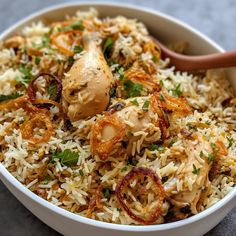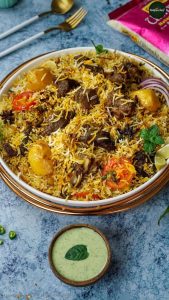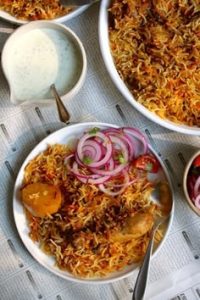Chicken Biryani pakistani:
often regarded as the king of Pakistani cuisine, is more than just a dish; it’s a celebration of flavors, tradition, and culinary artistry. Biryani is synonymous with festivals, weddings, family gatherings, and special occasions across the country. Whether you’re in Karachi, Lahore, or Islamabad, you’ll find that chicken biryani holds a cherished place in the hearts (and on the plates) of millions.
From its complex layers of rice and tender chicken to the aromatic spices and herbs, biryani is a symphony of flavors that tells the story of Pakistan’s rich culinary heritage. In this post, we’ll explore everything there is to know about chicken biryani in Pakistan, including its history, cultural significance, different regional variations, how to make the perfect biryani, and much more.
The History of chicken biryani pakistan: Origins and Evolution
While the exact origins of biryani remain debated, most historians agree that it has its roots in the Indian subcontinent and was influenced by Persian cuisine. The word “biryani” is derived from the Persian word “birian,” which means “fried before cooking.” Biryani was believed to have been brought to the subcontinent by Mughal emperors in the 16th century, who introduced the Persian way of cooking rice with meat and spices.
Over time, biryani became a beloved dish, especially among the royalty and nobility, as it was seen as a luxurious and elaborate meal. In Pakistan, the dish evolved to include a variety of local spices, herbs, and cooking techniques, reflecting the country’s diverse culinary landscape.
Cultural Significance of Chicken Biryani in Pakistan
In Pakistan, biryani is much more than a meal—it is a part of the country’s social and cultural fabric. No festive gathering, whether it’s a wedding, Eid celebration, or family reunion, is complete without a steaming pot of biryani at the center of the table. It is often seen as a dish that brings people together, signifying joy, celebration, and hospitality.
In fact, biryani has become so embedded in Pakistani culture that it is often used as a marker of regional pride, with different cities and provinces boasting their own unique styles and recipes. Karachi, in particular, is known for its spicy, bold version of biryani, while Lahore and other regions have their own distinct takes on the dish.
Key Ingredients in Pakistani Chicken Biryani
At its core, chicken biryani is a layered dish of rice and chicken, but it’s the spices and herbs that make it truly magical. Let’s break down the key ingredients that go into making an authentic
1. Rice
Long-grain basmati rice is the preferred choice for biryani due to its delicate fragrance and fluffy texture. The rice is typically parboiled before being layered with the chicken and cooked until fully done.
2. Chicken
Bone-in chicken pieces are often used for biryani as they add flavor and richness to the dish. The chicken is marinated in a blend of yogurt, spices, and herbs before being cooked.
3. Yogurt
Yogurt plays a crucial role in tenderizing the chicken and forming the base for the masala (spice mixture). It also adds a creamy, tangy flavor to the dish.
4. Spices
Biryani is known for its robust spice profile. Common spices include cumin, coriander, garam masala, cinnamon, cardamom, cloves, and bay leaves. These spices are toasted to release their essential oils, which infuse the rice and chicken with their aromatic flavors.
5. Onions
Fried onions, also known as birista, add sweetness and depth to the biryani. They are often used both in the marinade for the chicken and as a garnish on top of the rice.
6. Herbs
Fresh herbs such as mint and cilantro are used to brighten the flavors of the biryani. They add a burst of freshness to balance the richness of the spices and chicken.
7. Saffron or Food Coloring
Saffron, when available, is dissolved in warm milk and sprinkled over the rice to give it a golden hue and subtle fragrance. In some cases, food coloring is used to create the traditional yellow and white contrast in the biryani.
8. Ghee or Oil
Ghee (clarified butter) or oil is used to fry the onions and coat the rice, adding richness and flavor to the dish.
9. Tomatoes
Tomatoes are often used in the biryani masala to add a slight acidity and moisture to the chicken, helping to create a more flavorful base.
Regional Variations of Chicken Biryani in Pakistan
While the basic ingredients of chicken biryani remain the same, there are several regional variations across Pakistan, each with its unique blend of spices, preparation methods, and flavors.
1. Karachi Biryani
Karachi is known for its bold and spicy version of chicken biryani, often referred to as “Bombay biryani” due to its roots in the Indian city. Karachi biryani typically uses more green chilies and has a fiery heat that sets it apart from other versions. Potatoes are also commonly added to Karachi biryani, making it a more hearty and filling dish.
2. Lahori Biryani
Lahori biryani is milder compared to the spicy Karachi version, focusing more on aromatic spices than heat. It is often cooked with a generous amount of ghee, giving it a rich and buttery flavor. The chicken is usually marinated for longer, resulting in tender, flavorful pieces of meat.
3. Hyderabadi Biryani
Hyderabadi biryani, which has found its way into Pakistani kitchens, is a more intricate and layered version of the dish. It uses a combination of raw and cooked ingredients, with the chicken and rice being cooked together on dum (slow heat). Saffron and rose water are commonly used in Hyderabadi biryani, adding a floral note to the dish.
4. Sindhi Biryani
Sindhi biryani is another popular variation, known for its distinct use of tomatoes and potatoes. The biryani masala in this version is usually spicier and tangier, with a higher emphasis on sour elements like yogurt and lemon juice. The rice in Sindhi biryani is often more colorful, with vibrant hues of yellow and orange.
5. Peshawari Biryani
Peshawari biryani is simpler and less spicy compared to its southern counterparts. The focus here is on fewer spices, allowing the flavor of the chicken and rice to shine through. Often cooked with minimal masala, this biryani is more subtle in flavor but still delicious in its own right.
How to Make Chicken Biryani: Step-by-Step Recipe
Making chicken biryani at home can seem like a daunting task, but with the right technique and patience, you can create a restaurant-quality dish in your own kitchen. Here’s a step-by-step guide to making an authentic Pakistani chicken biryani.
Ingredients:
- 2 cups basmati rice, washed and soaked for 30 minutes
- 1 kg bone-in chicken, cut into pieces
- 1 cup yogurt
- 2 large onions, thinly sliced
- 3 tomatoes, chopped
- 4 green chilies, slit
- 1/4 cup ghee or oil
- 1 tbsp ginger-garlic paste
- 1 tsp cumin seeds
- 2 cinnamon sticks
- 4 cardamom pods
- 4 cloves
- 1 bay leaf
- 1 tsp red chili powder
- 1 tsp turmeric powder
- 1 tsp garam masala
- 1 tsp coriander powder
- Salt to taste
- A handful of fresh mint leaves
- A handful of fresh cilantro leaves
- 1 tsp saffron threads soaked in warm milk (or food coloring)

Step 1: Marinate the Chicken
In a large bowl, combine the chicken pieces with yogurt, ginger-garlic paste, red chili powder, turmeric powder, and salt. Mix well and let the chicken marinate for at least 1 hour, preferably overnight for more flavor.
Step 2: Fry the Onions
Heat ghee or oil in a large pan and add the sliced onions. Fry until golden brown and crispy. Remove half of the fried onions and set aside for garnish.
Step 3: Cook the Chicken
To the same pan with the remaining fried onions, add cumin seeds, cinnamon sticks, cardamom pods, cloves, and bay leaf. Sauté for a few seconds until aromatic. Add the chopped tomatoes and green chilies and cook until the tomatoes are soft and the oil starts to separate.
Add the marinated chicken to the pan and cook until the chicken is browned and partially cooked through. Add garam masala and coriander powder. Stir in the chopped mint and cilantro leaves.
Step 4: Cook the Rice
In a separate pot, bring water to a boil and add salt. Add the soaked rice and cook until it is 70-80% done. Drain the rice and set aside.
Step 5: Layer the Biryani
In a large pot, spread a layer of the chicken mixture on the